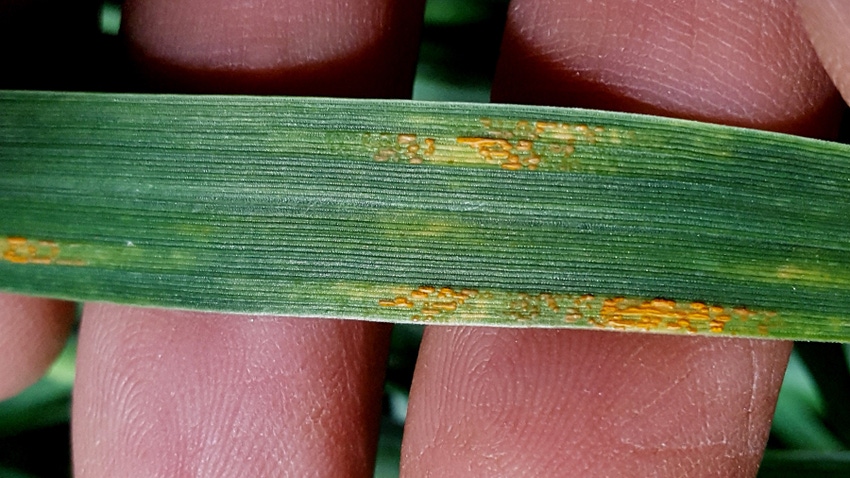
The 2024 Kansas wheat crop is progressing, and farmers are holding their breaths in the hopes that this crop will make harvest.
USDA NASS reports that for the week ending April 7, the state’s winter wheat crop was 49% good to excellent, with 37% fair and 14% very poor to poor. And one-third of the wheat has jointed, ahead of 2023 and the five-year average.
High wind events and variable temperatures have scoured some fields, while others are facing rust coming in on southern winds and other disease pressures. Here’s what farmers and experts are reporting from around the state.
Wheat streak mosaic virus
The 2023 harvest was delayed by several moisture and weather events, which led to more volunteer wheat left in fields through the fall and winter. This created the right conditions for harboring the wheat curl mites that are vectors for wheat streak mosaic virus.
Kansas State University wheat disease specialist Kelsey Anderson Onofre warns growers that as temperatures rise, they may see the typical “streaking symptom” of infected plants in their fields as the warmer weather activates the virus’ symptoms.
“We had some unfortunate rainfall right around harvest, so that kept wheat in the field a little longer than we might have wanted to see it. We could have had some shattering or some volunteer from that wheat being left,” Onofre said in a news release. “We also had hail, so there were swaths of hail that came in prior to harvest. That hail knocked that wheat right out of the plant, and that will cause some volunteer to emerge.”
Other wheat diseases that experts encourage Kansas growers to watch for include wheat soilborne mosaic virus, wheat spindle streak mosaic virus, barley yellow dwarf and stripe rust. More information is available at local Extension offices in Kansas.

DROUGHT MONITOR: The U.S. Drought Monitor map for April 9 shows much of the state under abnormal to moderate drought conditions, with pockets of severe drought. (Courtesy of U.S. Drought Monitor)
Spring weather extremes
Kansas saw a freeze across much of the state in March, and the April 6-7 weekend of high winds approaching 40 to 50 mph in some spots had some farmers concerned about their field and crop conditions. According to Kansas Wheat, farmers in the central third of the state are monitoring drought conditions as the crop approaches the critical phase.
Mike McClellan, Plainville, said his late-planted wheat emerged late, in the first part of March, which meant it escaped most freeze damage. But, as the wheat starts to get some growth, farmers are now worried about moisture and high winds drying out soil.
Martin Kerschen, who farms in Reno and Sedgwick counties, says ponds are still dry, and his wheat is starting to show that “blue tint” of drought stress. This, on top of freeze, damaged tips from the late March event. Upcoming predicted warmer temperatures in the 80s may also hurt the crop as it tries to overcome the previous stressors.
Still, farmers are optimistic where there was moisture this past fall and winter to build soil profiles, and they could get their wheat drilled in in a timely fashion.
Jason Ochs, Syracuse, says his area received “adequate but extremely variable moisture over the winter,” according to Kansas Wheat’s report. “The wheat drilled in absolutely beautifully, and we got a good stand right off the bat,” he says in the release. “It’s a nice change.”
Stripe rust blowing in
As usual, Kansas farmers are watching their neighbors to the south in Oklahoma and Texas for reports of stripe rust that can blow into the state on southern winds. Jeff Seiler, K-State Agriculture and Natural Resources Extension agent in Sedgwick County, reported traces of stripe rust east of Caldwell in Sumner County April 9. Some plants had already reached flag leaf stage, according to his post via his account, @SGAgAgent on X (formerly Twitter).
Onofre says in the March 21 Agronomy eUpdate that historically, detections of stripe rust in Kansas before April 15 have been associated with bad stripe rust years. There was moderate to high moisture in Texas in the fall, which is favorable for rust to develop and spread. “Of course, stripe rust severity in Kansas is still largely driven by weather conditions in the state in the late spring and the varieties planted,” she writes. “Once stripe rust is detected in Kansas, cool evenings and extended periods of canopy moisture will be necessary for disease establishment at levels that would result in yield loss.” But, if the weather turns hot and dry, that rust has fewer opportunities to take hold.
Farmers can view reports of stripe rust online at wheat.agpestmonitor.org. Additional information about early fungicide applications on wheat can be found at "Considerations for early fungicide applications on wheat in 2024.".
About the Author(s)
You May Also Like






